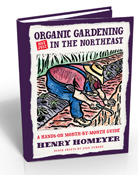Horseradish
Posted on Monday, September 26, 2016 · Leave a Comment
The strong flavors of horseradish tend to create strong feelings: you either love it or you hate it. I love it on a roast beef sandwich or in a shrimp sauce. For most people, horseradish comes in a small bottle that languishes forever on the door of the refrigerator. But, just like tomatoes, fresh homegrown is better than the store-bought kind, so you may wish to grow your own. This is the time of year most people harvest and plant horseradish, though you can do either almost anytime.
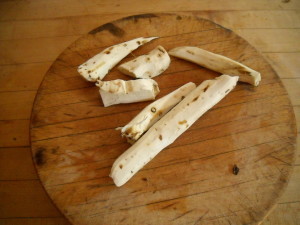
Peeled horseradish
Horseradish, along with rhubarb and asparagus, is one of the few perennial vegetables we can grow in New England. Once you have it, you will always have it – even if you decide you don’t want it anymore – so think where you want it before planting. Fortunately, a small patch doesn’t increase in size very quickly. About the only way to get rid of horseradish (or at least for an organic gardener who eschews herbicides) is to turn the patch into lawn. Even then, new shoots will come up through the lawn decades later.
Once established, the roots go down two feet or more into the soil. Because the roots branch and they are brittle, one can never get all the roots out. Even a scrap of the root will re-sprout, so the plants are there for life. Horseradish is as persistent as it is piquant.
Horseradish is in the cabbage family, but unlike its kissing cousins, it is the root, not the leaves, that you eat. And unlike other crucifers, horseradish is not started by seed, but by planting a cutting. The Johnny’s Selected Seeds catalog (www.johnnyseeds.com or 877-564-6697), one of very few that offer cuttings, explains that the seeds are not viable. They ship cuttings in April, “after danger of freezing in transit has passed.” But you can also get cuttings from a friend who is harvesting now and plant some this fall.
Prepare a horseradish bed by working in some well-rotted manure or compost. That will improve soil texture and keep the soil looser – for ease in future harvesting. Horseradish, which is essentially a weed, doesn’t need high levels of nitrogen, phosphorus or potassium.
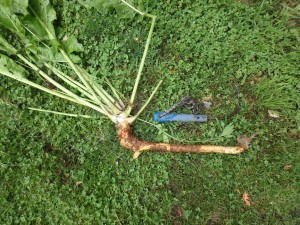
Horseradish root
To prepare a cutting for planting, dig a root from an existing plant and slice off the leaves. Plant the crown (where you cut off the leaves) and a section of root – 3 to 6 inches of root is fine. Plant the cuttings a foot or more apart. Water well, and surround with mulch to keep down the weeds. In a year or two you will be ready to harvest. Younger roots are easier to use for sauce than old, woody roots. Horseradish does best in well-drained soil, but really will grow anywhere. It will be most vigorous in full sun, but 4 hours is plenty.
To harvest, loosen the soil around a plant, either with a garden fork or a drain spade. Drain spades have blades that are about 16 inches long and 5 inches wide, and are great for digging out deep-rooted things like horseradish. A mature root will challenge even the strongest backs, so you may need to sever the root with your spade to remove it.
Prepare the horseradish for making sauce by hosing off the dirt, then peeling the dark brown skin to reveal its white interior. A potato peeler works just fine for that. The fumes of horseradish are very pungent, so think about working outdoors on a breezy day.
Horseradish root is tough stuff and can defeat your food processor unless you chop it up a bit by hand. Slice a chunk of horseradish lengthways into sections, then chop into pieces about ¾ inch in length before putting in the food processor. To prepare the sauce, grind the chopped roots in the food processor with a little cold water. Pulse the horseradish until it is coarsely chopped.
Grinding the roots releases the volatile oils (isothiocyanates), which give horseradish sauce its heat. Adding vinegar, besides adding flavor and helping to preserve the sauce, controls the level of heat. Add vinegar immediately, and the sauce is moderately hot. Wait 3 minutes before adding vinegar and the sauce will be spicier. In any case, blend the vinegar with the ground root until the consistency is moist and creamy. Add salt if you are so inclined. Put in a glass jar and store in the fridge.
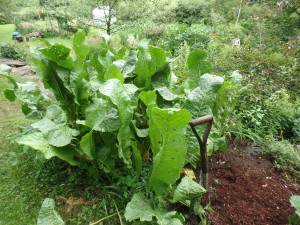
Horseradish Plants
The nice aspect of horseradish, for gardeners who want it for their kitchen, is that it is essentially labor free. Plant it, and walk away. The outer leaves, which are a bit coarse-looking, will sometimes get brown and scraggly-looking, and slugs will occasionally nibble them, but the plants are trouble-free. They’ll be there, just waiting for you to harvest the roots. Now, if someone would just create corn and tomatoes that were so undemanding, everybody would garden.
Sidebar: Shrimp Cocktail Sauce
4 ounces tomato ketchup
1-2 tablespoons fresh, home-made horseradish sauce
Juice of ½ lemon
Sprinkle of Worcestershire sauce
Black pepper and salt to taste
Blend ingredients in a small bowl, sampling and adjusting until perfect.
Read Henry’s blogs at https://dailyuv.com/gardeningguy. His website is www.Gardening-guy.com. He is on vacation and will not be answering-mail this week.
Fall Flowers
Posted on Monday, September 19, 2016 · Leave a Comment
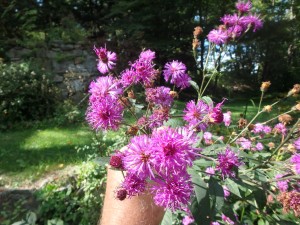
New York Ironweed
Almost every flower gardener has great June flowers: peonies are dramatic and go well with the Siberian iris that bloom at the same time. Bachelor buttons are blooming and poppies are popping out everywhere. But now, in September, some gardens have plenty of green but lack color. It need not be that way.
The first and easiest “quick fix” are the chrysanthemums that are for sale everywhere. Although many are sold as “perennial”, I treat them as annuals. That is because it order to get a clump of mums to have hundreds of blossoms, someone has to cut back the growing stems at least once, and probably twice.
After cutting them back in June, each stem sends out two or more new branches, each of which should flower. But on the occasions when I have let mums come back, I rarely did that. So to me, it is worth just buying new ones every year.
The same technique of cutting back early stems is used for those intensely purple fall asters that are for sale at farmers markets and grocery stores. I love them, and I am willing to pay someone to create that dense crown of blossoms. I often put them along my front walkway or keep them in pots on the front steps. Left on their own, they get much taller.
But what about perennials that come back every year? Sneezeweed (Helenium autumnale), tall New England asters, turtlehead, Sedum ‘Autumn Joy’ and Joe Pye weed are commonly planted. But let’s look at some others you may not know.
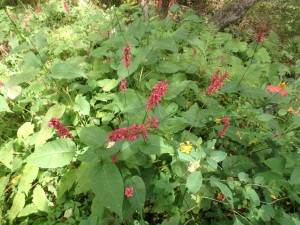
Persicaria
A lesser-known plant that has been flowering for me for many weeks and still looks good is pink bistort (Persicaria bistorata Superba, also called Polygonum bistorta). It has pink to red bottlebrush flowers that stand up 2 to 3 feet, rising above glossy green foliage. It is a skinny little flower – actually lots of little flowers on a forked thin stem. Each group of flowers is 2 to 3 inches. They grow, for me, near where my primroses bloom in spring – under an old apple tree with rich, moist soil. It does well in a vase.
Also in bloom for me is ‘Henry Eilers’, a named variety of Rudbeckia subtomentosa. It was found growing in the wild in Montgomery County, Illinois by Mr. Eilers, and introduced to the gardening world in 2003. It is unlike most black-eyed Susans (Rudbeckia) in that it has gaps between the petals, giving it a distinctive look. Each petal looks as if it were carefully cut out with scissors – with a straight edge and separated from the next, like teeth on a Jack-o-lantern.
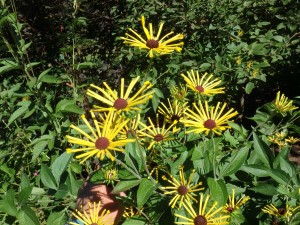
Henry Eilers Rudbeckia
Henry Eilers is usually a very nice plant and requires little or no staking. This year mine grew to be 6 feet tall and is flopping over. Each year any given plant tends to grow differently.
New York ironweed (Vernonia noveboracensis)is another tall plant in bloom for me now. According to my bible for flowers, a wonderful 800-page book called Manual of Herbaceous Ornamental Plants by Steven M. Still, ironweed likes full sun with moist acidic soil. I moved mine from such a location to a drier location with part shade. I did so because it was too vigorous and too tall and floppy, when given ideal conditions. Even so, it is about 6 feet tall and somewhat floppy. It has intense purple flowers similar to those short asters for sale right now.
Fall anemones (Anemone japonica and hybrids) are fabulous flowers, albeit a bit fussy. They come in shades of pink and white with lovely 5-petaled blossoms 2 to 3 inches across. I have lost them more than once as they really do not like moist roots in winter, but need plenty of moisture in summer. That’s a tough requirement. According to the book mentioned above, they want morning sun and filtered afternoon sun. But if they are happy for you they will spread and produce plenty of great fall blossoms. I’d say, plant them in rich dark soil in a well-drained location, and water regularly if it is a dry summer.
Another great fall flower is called “showy autumn crocus”, but they are not really crocus. They areColchicum, a different genus of bulb flowers. They look like crocus on steroids- they have 4 to 6-inch flowers on long tube-like stems. They pop up now without leaves; leaves appear in the spring, then disappear.
The stems have little strength, so they generally flop over. For me, they always flop over, except for a few of the doubles, which sometimes stand up. One way to avoid the flop factor is to plant a ground cover like myrtle or pachysandra in the same area. The vines support the flowers a little.
So go visit your favorite garden center. You might be surprised what you find – fall flowers are still blooming.
Read Henry’s blogs at https://dailyuv.com/gardeningguy. His website is www.Gardening-guy.com. He is on vacation and will not be answering-mail this week.
It’s Harvest Time!
Posted on Monday, September 5, 2016 · Leave a Comment
My garden is finally paying me back for all the work I’ve done this year. I’m putting up the harvest and eating vegetables until they (almost) pop out of my ears. It’s been a great summer.
Let’s look at how to know if your vegetables are ready to harvest, as it’s not always obvious. Potatoes, for example, are not obvious – the tubers are underground. The earlier you harvest, of course, the smaller the potatoes. But you can snitch a few after they have bloomed. If you have loose fluffy soil you can poke your hand into the soil under a plant and grab a spud without disturbing the plant – or the other potatoes that are still growing. Or you can dig up one plant and leave the others to grow.
To avoid damaging potatoes at harvest time, plunge a garden fork into the soil a foot from the plant, tip it back, and the roots – spuds and all- will be visible. Grab ‘em, but place gently in a bucket so as not to damage the still tender skins. Harden off in a cool, dark place – and leave the soil on if you want to store them.
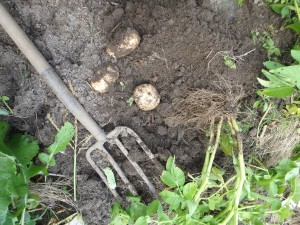
Kennebec potatoes picked now are a good size
Generally I let potatoes grow through September, harvesting only after the leaves have yellowed and died back. But I keep testing to see if they have reached the size I like. Some varieties develop hollow spots in the center if they get too big. That’s not a big issue for me. But I don’t want them too small and I generally start mine in June, long after most gardeners have started theirs. I do that to minimize potato beetle damage, and it seems to work. I didn’t see one beetle this year!
I grew artichokes again this year, though I don’t always. It is often hard to know when to pick them – an immature artichoke looks exactly like a mature one, but for the size. Same color, same feel if you squeeze them. But if you wait too long, the leaves get hard and unappealing. I picked my first ‘choke when it was about 3 inches across and didn’t seem to be getting bigger. That plant also produced a second flower (artichokes are actually flowers), and I picked it when it was about half the size. Again, it seemed to have stopped growing.

Artichoke
Summer squash can be picked at any size from tiny to mammoth. My favorite variety is ‘Romanesco’, which has stripes along its ribbed sides. I like it small, but it is still good to eat even if it “escapes” and gets huge. I just take a big spoon and scrape out the seeds. Generally I grate the big ones in my food processor and freeze the results in zipper bags for use in winter soups. I don’t blanch the squash, but do try to use it within a few months. Blanching kills enzymes that promote aging, while freezing does not. So squash is less appealing after months in the freezer.
It is tougher to know when winter squash is ready to pick. In general it is best to let winter squash like butternuts and hubbards stay on the vine until the leaves start to yellow and the stems turn brown and dry. But the best test is what I call the “fingernail” test: push your thumbnail against the skin. It should be tough enough that your nail leaves no mark. If you feel it digging in, stop pushing your nail against it.
When picking winter squashes or pumpkins, bring a sharp knife or a pair of pruners so that you can cut the stem, leaving a 3 inch “handle”. But don’t carry it by the handle, as you don’t want it to pull off. Most winter squashes also need some time in a warm sunny place to cure after being picked. Acorn squashes should go directly to a cool location, as they can get stringy if left in the sun. Always store winter squash in a low humidity area.
Never, I repeat never, let winter squash get frosted. If you don’t want to harvest them and frost is forecast, pull the comforter off you bed and cover them up. Or use an old sheet, I suppose, or even a plastic tarp.
Speaking of frost, which I hope is still weeks away, here are some veggies that will not survive even a light frost: basil, beans, cucumbers, eggplants, peppers, tomatoes and squash of all types.
On the other hand, plants that survive light frost include artichokes, beets, carrots, cauliflower, celeriac, lettuce, parsnips and Swiss chard. Plants that can still thrive after a hard frost include broccoli, Brussels sprouts, cabbage, kale, kohlrabi, parsley, radishes, spinach, turnips and leeks. I often pick kale and Brussels sprouts in December.
My onions were ready to harvest weeks ago. I know when they are ready to pull because the tops flop over. I cure them in a warm sunny place outdoors until the tops dry up. I store them, along with winter squash, in a low-humidity cool location indoors.
Growing vegetables really is for cooks. I probably would only grow flowers if I didn’t love fresh veggies so much. And of course being able to store and use my vegetables all year makes all that work even more worthwhile.
Want to have big Brussels sprouts? Read Henry’s blog for a 10-second trick: https://dailyuv.com/news/859799. Henry is the author of 4 gardening books. His website is www.Gardening-guy.com.
Are Blueberries For the Birds? Or For Us?
Posted on Wednesday, August 31, 2016 · Leave a Comment
I gave a lecture and slide show recently about good plants that support our feathered friends. I talked about good habitat for nesting and safe places to rest while avoiding cats. But when I showed plants birds like to eat, some gardeners were surprised when I showed blueberries: they didn’t want to share. Many of those same people buy black oil sunflower seeds in 50 pound bags every month all winter. But share the blueberries? No way. If you don’t want to share, let’s look at the options.
Years ago when I was in the category of “blueberries are for me, not the birds” I developed an easy netting system that kept the birds off – but I no longer use it. Netting allows the birds to see those ripe berries, taunting them if you will, and some will get caught in the netting trying to get in. A friend recently reported finding 3 dead and rotting birds in the blueberry netting of a friend who was away. I haven’t used nets in years.
But let’s assume you want to net and are willing to check the nets frequently for caught birds. I suggest using tall plastic hoops that will allow you to drape wide swaths of netting over the bushes and easily slide it off to pick.
Buy 10 foot lengths of PVC pipe that is ¾ inches in diameter. For smaller bushes, cut some pipes in half and glue them to full length pieces to produce 15 foot long pipes. For large mature bushes, use 2 full lengths. Every 10 feet of a row of blueberries needs a hoop. Just bend the pipe to make a hoop, and push into the soil. I kept the netting in place with hair clips, the kind with 2 rows of teeth and a spring. On the ground I used landscape staples to hold the netting down and keep birds out.
I called my buddy Chris Dye of Noda’s Blueberry Farm in Meriden, NH (www.nodafarm.com). He said they bought a noise maker to keep the birds at bay. It’s called a Bird Gard Pro. (http://www.birdcontrolpro.com).It makes random bird distress and predator sounds to keep birds away, protecting about an acre of berries. He has a 12-volt car battery to power it, and it sits up 10 feet or more in the air. Aside from the sounds of distressed birds, which would make me loony in no time, the cost would prevent me from getting one: $229.95. Of course, blueberries are his business, so he has to protect the 2 acres of berries they grow.
Then I called Riverview Farm in Plainfield, NH and talked to Nancy Franklin. She and her husband have a huge fruit operation – apples, blueberries, raspberries, pumpkins and more (http://www.riverviewnh.com/). Nancy said that their berries are mostly late-season varieties, especially one called ‘Elliot’. By the time they are ripe, many of the bird culprits are getting ready to migrate and have changed their feeding habits, and are less of a problem. So they share a few, but don’t lose too many.
One problem with late-season berries whether blueberries, raspberries or strawberries is a new pest that arrived a few years ago: the spotted winged drosophila, a foreign fruit fly. Unlike our native fruit flies, this one attacks good fruit, not rotten fruit. So I don’t recommend any late season varieties until someone develops a predator insect that will control this new pest.
Birds evolved to avoid large predatory birds like owls and hawks. So you can buy a plastic owl and put him out in your blueberry patch, but birds aren’t stupid. Unless you are going to move it from tree to tree, they’ll figure out it’s not real.
Birds don’t like shiny things, either. I’ve known gardeners to hang old music CD’s they no longer enjoy in the bushes. The wind blows them, and they shine light at the birds. But then again, in time, they might start rocking to “Grandma Got run Over by a Reindeer” instead of flying away.
I also have some Nite Guard Repellent tape. This is shiny tape designed to scare birds with movement, noise and light (http://www.niteguard.com/). At $15 for a 100 foot roll, it is affordable – and probably helps.
I have a bumper crop of blueberries ripening up now on my 7 bushes. I attribute that to the fact that I have been spreading agricultural sulfur around the bushes for a few years, getting the soil very acidic. Soil pH is very important, and you can add sulfur any time. But don’t add acidic fertilizer now (Holly-Tone, for example) as that should be done in early June. Fertilizer now would stimulate new growth which could easily be damaged in winter.
So this year I decided to put Reemay or “row cover” over my bushes. It’s a light-weight agricultural fabric designed to keep bugs off crops. I keep it in place with ordinary wooden clothes pins. It only cover the top of the bushes, or a little of the sides, but birds flying over won’t see it. And if my resident robins want to go on the ground and pick up berries, why not? There is nothing to harm the birds, and it is an inexpensive, quick–to-install solution. So put me in the category of “willing to share – a little – with the birds.”
See Henry’s twice-a-week blog at www.dailyuv.com/gardeningguy. He is the author of 4 gardening books, and a lifetime UNH MasterGardener.
On Becoming a Good Gardener
Posted on Tuesday, August 30, 2016 · Leave a Comment
At a neighborhood cookout I met a woman who asserted that she had a “brown thumb.” Although this is not the first time I’ve heard someone say they couldn’t grow anything, I always take issue with such statements. No one is born with an ability to garden; some of us become good gardeners over time as we learn, and as we improve our soil. Good gardeners learn from their mistakes – I’ve killed plenty of plants, but I try not to let that discourage me. Good gardeners observe our gardens carefully, visit other gardens, and read the words of other gardeners.
Ms. Brown Thumb was surprised to learn that I went to my garden every day, generally several times a day. She just visits hers on the weekends. Good gardeners pull a few weeds every day, pick bugs, and marvel at the wonders of their flowers.

Good gardeners pick Japanese beetles by hand
She was also bothered by bugs. She didn’t want to be bitten by them, or, I gather, touch them; I imagine handling slugs or snails would be unthinkable for her – though routine for me. Many of my gardening friends think nothing of squishing snails or Japanese beetles between their fingers, though others prefer dropping them in soapy water. Still, bugs are a part of gardening.
Observation is important. If you don’t see what is eating your squash or potato leaves, turn over the leaf. Chances are you’ll find the culprit – or a clue like their eggs. Go out at dawn, or just before bed with a flashlight to see what the problem is. Good gardeners are amateur sleuths, too.
My grandfather, John Lenat (1885-1967) was a great gardener. He always had a compost pile full of earthworms made from weeds, kitchen scraps, and chicken or cow manure. He treated his soil and plants to liberal doses of compost when he planted, and often gave his tomatoes manure tea that he made in an old wooden barrel. We mixed hen manure and water (roughly 4 parts water to one part manure), stirred it daily, and fed his tomatoes one 12oz can of tea at least once a week.
Good gardeners love being outdoors, and don’t mind getting dirty. Remember the character Pig Pen in Charles Schultz’s comic strip, Peanuts? Gardeners are a bit like that. I am forever wiping my hands on my pants so that I can clean my glasses or dig a knife out of my pocket.
I have a network of gardening friends, and we are forever exchanging ideas and plants. Sometimes we even get together to help a friend catch up on weeding – a grand idea if you get behind – or just to have a potluck and talk gardens. I recommend it.
Garden clubs are another great way to learn about gardening. Although the summer is about over, many clubs have garden tours each summer. I love to visit gardens that are not open to the public. There is nothing like seeing how another gardener designs a garden, or the conditions that a particular plant likes.
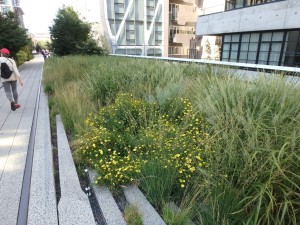
The High Line garden offers good ideas
Public gardens are wonderful resources, too. I just visited the High Line, a garden in New York City that was built on an abandoned elevated railway line. It’s over a mile and a half long and has a fabulous collection of not only of perennials and grasses, but trees and shrubs, too. I brought my camera and a notebook to record the walk, and to help me remember names of plants I want to research.
Books can be a great help when it comes to gardening, too. Even experienced gardeners can be reminded of facts we forget. How many years are bean seeds good for? How about onions? I find myself going back to Ed Smith’s book, “The VegetableGardener’s Bible” (Storey Publishing) to jog my memory. And Barbara Damrosch’s “The Garden Primer” (Workman Publishing) is a great resource on many topics; I assigned it to my students when teaching college-level sustainable gardening. I’ve even been known to refer back to books I’ve written on occasion! We can’t remember everything.
I know that the internet is a great resource, too. As an older gardener I tend to reach for books on my shelf when I have a question, but I’m increasingly using Wikipedia or university sites for information. And I’ve been able to identify wild plants by using Google – I just list three characteristics of a plant, and it presents me with a number of options – including the right one.
The key to having a green thumb, I think, is to get to know soils –and how to improve them. Good compost is full of organic matter and living beneficial organisms. I add it liberally to my soil and have for years. Now plants beg to come home with me so they can thrive and have babies. Of course, the weeds do, too!
Read Henry’s blog posts at https://dailyuv.com/gardeningguy. He is the author of 4 gardening books.
Mid-summer Tasks in the Garden
Posted on Wednesday, August 24, 2016 · Leave a Comment
By now my gardens are well established and most plants are doing well. But there are tasks, both in the vegetable garden and in the flower beds, that need my attention.
Weeding is key in both areas, and recent rains make doing so easier as the soil has softened up. If you have very dry soil where you are, you might want to water well before weeding.
Why worry about weeds? I know gardeners who don’t do much weeding in their vegetable gardens. One even told me that if he weeded too much the deer would find his vegetables! But weeds anywhere in the garden are going to spread seeds soon – whether in the walkways or up close to your tomatoes. And seeds will come back to make more work now – and in the years to come. Many weed seeds act like time release capsules, some germinating now, some later, some 5 years down the road.
Weeds compete with your plants for moisture, soil nutrients – and even sunshine as they get bigger. I use a CobraHead hand weeder (www.CobraHead.com). It’s shaped a bit like a curved finger with a sharp pointy spade-shaped tip about an inch across. It easily gets under weeds so that I can pull from above (with one hand) and from below (with the CobraHead) at the same time, or tease long roots out of the soil without breaking them.
Thinning your carrots, beets and other root crops is an urgent job if you haven’t done so yet. Like weeds, vegetables growing too close to one another will compete for sun, water and nutrients. Carrots and beets should be at least an inch apart by now. And in a month, you need to thin them to 2 inches apart. Pulling the sharp tip of a CobraHead alongside a row of carrots will loosen the soil, sever a few side-growing roots, encouraging those that go deep. And scratch in some organic fertilizer now, too. It will help you get bigger carrots.
By the way, you can transplant carrots as you thin them out. Poke a hole deep enough so that the carrot will not bend, drop it in, press down the soil, water. It’s not a 100% reliable technique, but I hate to kill plants and have found it works most of the time. Do it in the evening, so they will have all night to recover before the hot sun hits them.
My onion patch was recently weeded, but I know that weeds will be along soon. So I mulched my onions with grass clippings. I find they work better than straw or hay in tight quarters like the onions. And green clippings may add a little nitrogen to the soil as they break down.
In many gardens the lower leaves of tomatoes are starting to yellow and develop dark blotches, sure signs of early blight. Although this blight is not immediately fatal, it reduces crop yield. By the end of August stems are often bare of leaves. You can minimize it by pruning off the affected leaves and all lower branches that touch the soil or are near it. Work on your plants when they are fully dry as the disease spreads more easily when leaves are wet.
I use scissors to remove the leaves, dipping them frequently in a glass of rubbing alcohol to sterilize them between plants. I wash my hands in a bucket of soapy water between plants. To see an in-depth article about this procedure along with many pictures, go to https://dailyuv.com/news/851634.
I always plant my potatoes in June, even though manygardeners start planting them in April. I do this as I ‘ve found that I have fewer potato beetles by planting late. Maybe they’re all at my neighbors’ gardens. But do take some time to check yours to see if any beetles are eating the leaves. Look for larvae, and for orange egg masses on the underside of leaves.
When you plant your potatoes the roots will grow down below the seed potatoes and the new potatoes will form above them. Now is a good time to add soil over the developing potatoes. This is known as hilling them. I plant mine using a post hole digger, so it’s easy to fill in above my seed potatoes, just pushing the soil from mounds next to each plant. You can also use a hoe and scrape soil from the walkways. Don’t worry if some leaves get buried. They won’t complain.
In my flower gardens I am mainly weeding and cutting back flowers stems that have already blossomed. Weeding gives me space to plant new flowers – even though I have an extensive palette of plants, I constantly go to garden centers to see new things, or plants I once had that have disappeared. (Yes, I kill a lot of plants, we all do).
Cutting off spent flowers is good. Important. It takes a lot of energy to produce seeds. By pruning back the spent flowers, your plants have more energy to develop good roots and strong stems.
So get outside and enjoy summer and pull some weeds. Yougarden will look better and you’ll feel better, too.
Henry is a UNH Master Gardener and the author of 4 gardeningbooks. His website is www.Gardening-Guy.com. Read his twice-weekly blog at https://dailyuv.com/gardeningguy.
Free Flowers!
Posted on Monday, August 22, 2016 · Leave a Comment
Right now my front walkway is dominated by annual flowers, many of them that I did not plant – not this year, anyhow. First and foremost are the calendula. These are wonderful bright yellow flowers in the composite family, like daisies or sunflowers. They blossom and then drop seeds on the soil so they come back every year.
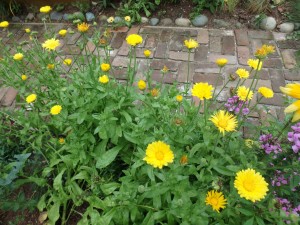
Calendula
To have a nice supply of calendula, all I had to do was leave some of the seedlings to develop this spring. The seedlings are easy to identify: their color is a bright green the color of young lettuce. I removed many, but left a dozen or so. Right now they are gorgeous.
Another of my annual favorites that seeds itself is a big, bodacious flower with white blossoms that are often more than 6 inches long and shaped like a trumpet: Angel’s trumpet or Datura. It comes in both white and purple forms, though I have not been impressed with the purple ones – they are much less vigorous, with fewer blossoms.

OLYMPUS DIGITAL CAMERA
Angel’s trumpet is my substitute for Asiatic and Oriental lilies which I can no longer grow- they are consumed and ruined by an invasive red beetle. Unlike the true lilies, Angel’s trumpet is not bothered by the beetles and blooms all summer. I have read that the seeds and flowers are poisonous – they produce severe hallucinations. But the seeds come in spiny covering, so few kids or animals are likely to want to put them in their mouths.
When I see their distinctive leaves in the spring I move them to a place where I have space for a plant that is often 4 or 5 feet across and 2 to 3 feet tall. Some years I get plenty of “babies”, other years I do not. They grow best in full sun to part shade in rich soil that stays a little moist.
Also on my front walkway is a tall plant with tough, thin, wiry stalks that often reach 4 to 5 feet, Brazilian verbena (Verbena bonariensis). In our climate this is an annual, but back home in South America it is a perennial. It has reddish-blue flowers, usually in groups of 3 at the tops of the stems. It rarely needs to be staked.
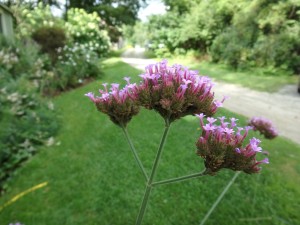
Brazilian verbena up close
Its spring leaves, important to recognize if you want free flowers, are in pairs with serrated edges and roughly the shape of an elongated tennis racket. Look hard at the leaves now, noting the color and texture – even though the mature leaves are greatly elongated.
Of course, if you want to get flowers to self-sow, you must allow seeds to fall on bare soil. Even a 1 or 2 inch layer of mulch will prevent most seeds from finding a home and growing. If you are well mulched, you will need to monitor the seeds so you can pull back the mulch and sprinkle some on the ground when they are brown and ripe.
But there are other ways to get lots of plants besides encouraging self-sowing. Some perennials spread by root, turning a small clump into a big one in now time at all. Bee balm (Monarda didyma) is one that is a well-known spreader. Of course it is a lovely flower and most of us are happy to have more. And it pulls up easily, so I don’t call it a thug. Mine do best in part sun – morning only – and soil that doesn’t dry out too much.
In a funny quirk of fate, one of the least obedient plants I grow is called obedient plant (Physostegia virginiana). This is a beautiful tall pink plant that grows and spreads like crazy! It is a great cut flower with square stems with little florets up and down it.
Here is what I recommend: If you want to grow obedient plant, put it in shade, and don’t give it too much moisture. I have it growing under a rosemary willow that has its lower branches pruned off, and it is lovely there. And if it grows towards the sun, it’s in the lawn where my mower will keep it line.
Obedient plant also comes in a form with green and white leaves. This spreads a little, but it is not a thug for me. Whenever you have white portions of leaves, the plant gets less food because there is no photosynthesis in the white parts. That will make them less able to survive our winters, too. Plantswoman Nina Klinck at E.C. Brown Nursery in Thetford, VT says, “A variegated leaf plant is one zone less hardy than the same plant with all green leaves.” I agree.
One last suggestion: Don’t fertilize thugs or any plants that might take off and run. The less nitrogen and other nutrients in the soil, the more likely it is that you can control overly vigorous plants. Even adding compost to the planting hole is giving it an advantage it does not need. Put a thug in dry, crummy soil and maybe, just maybe it will behave itself.
Read Henry’s blog twice weekly at https://dailyuv.com/gardeningguy. Henry gardens in Cornish Flat, NH. He is the author of 4 gardening books.
Mid-Summer Blues … and Reds and Yellows
Posted on Monday, August 15, 2016 · Leave a Comment
It’s been a hot dry summer and many gardeners are lamenting the lack of color in their flower gardens. While it’s true that this is a quiet period for many perennials, there are plenty of flowers that are blooming – and plenty more on the way. Let’s take a look.
First, there are the annuals. Annuals are flowers that only get one chance to continue their genetic line. If they don’t make seeds and get them in the ground, they will die out. Of course, those silly flowers don’t realize that all the big seed companies have plenty more seeds with similar or identical genetic material, and will be selling seeds for flowers just like them next year. But, not knowing that, annuals keep on blooming in hopes of perpetuating their genetic line.
Some annuals need to be dead-headed in order to keep blooming. We have to play the role of the deer or woodchuck or cow that might nip off the blossoms, signaling a need to produce more flowers and eventually seeds. If you don’t cut off the spent blossoms, the flowers will think they have down their job.
Annuals that need to be deadheaded include, but are not limited to the following: bachelor buttons, cosmos, gaura, gazanias, geraniums, marigolds, osteospurmum, pansies of all types, pincushion flower, salvias, snapdragons, sunflowers, verbenas and zinnias. Some of those, like marigolds and zinnias will bloom for long periods of time even if you don’t cut off the spent flowers. Many will branch and produce greater numbers of flowers after deadheading – cut off one snapdragon stem, get six more, for example.
Other annuals have been bred so that they are “self-cleaning.” That means that spent blossoms fall off and are replaced by new ones. Most impatiens are like that, along with some petunias. I have one petunia called ‘Night Sky’ from Burpee that has been blooming constantly since early June and all I have ever done is water it occasionally. What else? Angelonia, Supertunias, Superbenas, Million Bells (Calibrachoa), portulaca, dragon wing begonias, lantana, nemesia, torenia and oxalis.
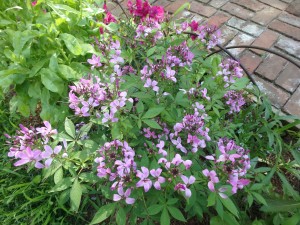
Cleome Senorita Rosalita
Two of my favorite self-cleaning annuals are trademarked varieties (Proven Winners) and are not available in six-packs or by seed, only in pricier 4-inch pots. But they are worth it. First is ‘Senorita Rosalita’ cleome. Unlike the generic cleome, it has no spiky thorn-like appendages and no cat-pee odor. It is a multi-stemmed beauty about 24 to 36 inches tall with 4-inch wide clusters of frilly pink flowers. A knockout. Another is a euphorbia called ‘Diamond Frost’. This has a mass of tiny white flowers, a bit like baby’s breath, that keeps blooming forever. I have grown it in pots and brought them inside for the winter, and it keeps on blooming! Fabulous.
Then there are the perennials. Yes, June has passed and the peonies and primroses and iris have all finished blooming. But there are nice things now: purple cone flowers, black-eyed Susans, phlox and cardinal flowers are all blooming for me now. They are easy, sun-loving flowers that do well in a vase, too.
A few words of advice about the perennials above: in general, the old standards fare better than many of the “new, improved” varieties. And I say that not as an old curmudgeon who doesn’t like change, but as one who has tested many kinds.
So, for example, I have planted hybrid cardinal flower (Lobelia cardinalis), only to have them die after the first winter – even when the pure species plants I had did not. That said, I‘ve had even my best cardinal flower plants die out after a few years. It is not a long-lived plant. It needs moist soil – it is found along the banks of the Connecticut River and I saw a huge patch alongside an abandoned beaver dam this week.
Similarly, I’ve had much better luck with standard varieties of purple cone flower (Echinacea purpurea) than the new hybrid colors such as peach, or yellow. I’ll stick with the old-fashioned pinky-purple ones, thank you very much.
Phlox is an old-fashioned plant, but many of the new named cultivars really are better. They’ve been bred to resist mildew, which makes so many of the old varieties ugly with spotted brown leaves. ‘David’ is a white one that I grow that is very nice.
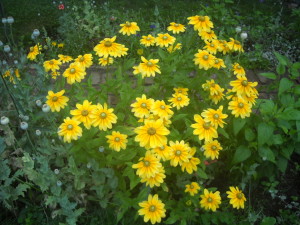
Rudbeckia Prairie Sun
I love a black-eyed Susan called ‘Prairie Sun’. It rarely over-winters for me, but I accept that flaw because it blooms profusely from July until October. I generally purchase some every year. It is not a hybrid, so sometimes the plants will self-sow, providing free plants. Right now mine are gorgeous.
In order to have blooms all the time – which I do from March to November – you have to keep on buying plants, trying plants, replacing plants. There is no “quick fix.” So visit your gardencenter and ask what they have to brighten up your garden now.
Read Henry’s blog twice weekly at https://dailyuv.com/gardeningguy. Henry gardens in Cornish Flat, NH. He is the author of 4 gardening books.
Going to Seed … or the Freezer
Posted on Monday, August 8, 2016 · Leave a Comment
My vegetable garden is producing more food each day than I can eat, but I’m trying to keep up with it by freezing, dehydrating and storing the bounty. And of course, I drive around with zucchini in my car, always looking for a willing recipient of some summer squash. But I am also deliberately letting some things go to seed.
We sometimes describe people who are going downhill and not paying attention to their appearances as “going to seed.” That’s an odd phrase, and has negative connotations. But I like letting lettuces and some other greens go to seed. Why? They will come back and produce early greens in the garden.
Once lettuce starts to elongate and get tall, also known as bolting, it starts to get bitter. If you pick it, you will notice white sap in the stem, usually a sign of bitter alkaloids. So you can pull it and toss it on the compost pile, or allow it to produce seed. Or eat it, if you like the flavor.
Most lettuces are not hybrids, so you can save their seed and get good free seeds. But read the seed package or catalog – or go on line and ask Dr. Google – to verify that the named variety you are growing is not a hybrid before collecting seed, or allowing it to self-sow. Anything listed as “heirloom” not a hybrid. (Hybrids are crosses of two varieties and do not usually breed true).
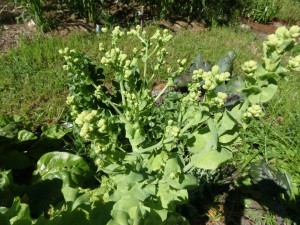
Lettuce going to seed
Lettuce normally self-pollinates as the stigma (which captures the male pollen) pushes up through the florets. If you want to cross breed lettuces, I have read that you can grow different varieties side-by-side and then tie two plants together when they have bolted and are about to produce flowers, thus facilitating cross breeding. I’ve never tried this, however.
If I want lettuce to produce seeds, I remove any newspapers and hay – the mulch I use – from around it. This allows seeds to fall freely into the soil where it will, generally, not germinate until next spring. Alternatively, one can take plants with dry seeds and shake the seeds out over a new, clean bed for lettuce next year.
I like to let a few other greens go to seed, too. Magenta spreen, amaranth and orach are other edible greens that I grow – but rarely have to plant. All are just one step from being weeds, and can be eaten raw or cooked. Orach has gorgeous purple leaves, and the spreen, particularly when young, has green leaves with pink edges. Amaranth has edible leaves, nice blossoms, and seeds that are eaten as grain in South America. Right now I have one spike of magenta spreen that stands 104 inches tall!
Tomatoes are starting to ripen for me: first the cherries, and now smaller plum tomatoes. In a few weeks those big, juicy heirloom tomatoes like Brandywine will be along – sending me, temporarily at least, to heaven.
I had a garden party recently and my guests were somewhat surprised to see that I have 30-some tomato plants. Although I share some of the fruit, I eat it fresh (3 times a day) and freeze the rest. I freeze whole tomatoes in zipper bags and cook with them all year.
To make these “red rocks”, all I do is wipe them clean and fit them into freezer-grade plastic bags. I place them on a cookie sheet in the freezer. When I want to make a soup or stew that calls for tomatoes, I just run a few tomatoes under hot water in the sink until I can easily rub off the skins. Then I wait a few minutes for them to soften, and cut into pieces for the soup pot.
Imperfect tomatoes I often make into tomato paste and freeze in ice cube trays until frozen, and then in zipper bags. I remove any imperfect spots and then core the tomatoes in the sink, squeeze out the excess seeds and juice, and puree in the Cuisinart. Then I boil down the puree for a few hours in a heavy enamel-clad cast iron pot. When I can literally stand up a spoon in the mix, it’s done. I leave it out all night uncovered to cool and to evaporate a little more moisture before spooning it into those ice cube trays.
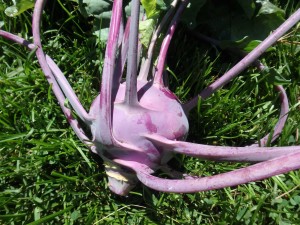
Kohlrabi
Kohlrabi has done very well for me this year. I started seeds in the house in the spring, and transplanted them into the gardening early summer. This worked better than planting seeds in the ground, as there was no thinning to be done and the plants are perfectly placed.
I peel raw kohlrabi and cut it up in salads, or cook it in stir-fry or stews. The purple variety I’m eating now is so pretty I’m going to use it as a centerpiece on the table tonight. Oh my, the pleasure I get from my garden!
Read Henry’s blog twice weekly at https://dailyuv.com/gardeningguy. Henry gardens in Cornish Flat, NH. He is the author of 4 gardening books.
Are Blueberries For the Birds? Or For Us?
Posted on Monday, August 1, 2016 · Leave a Comment
I gave a lecture and slide show recently about good plants that support our feathered friends. I talked about good habitat for nesting and safe places to rest while avoiding cats. But when I showed plants birds like to eat, some gardeners were surprised when I showed blueberries: they didn’t want to share. Many of those same people buy black oil sunflower seeds in 50 pound bags every month all winter. But share the blueberries? No way. If you don’t want to share, let’s look at the options.
Years ago when I was in the category of “blueberries are for me, not the birds” I developed an easy netting system that kept the birds off – but I no longer use it. Netting allows the birds to see those ripe berries, taunting them if you will, and some will get caught in the netting trying to get in. A friend recently reported finding 3 dead and rotting birds in the blueberry netting of a friend who was away. I haven’t used nets in years.
But let’s assume you want to net and are willing to check the nets frequently for caught birds. I suggest using tall plastic hoops that will allow you to drape wide swaths of netting over the bushes and easily slide it off to pick.
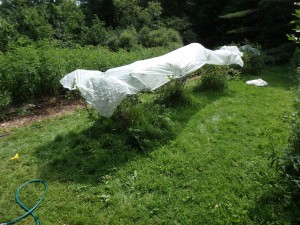
Row cover over blueberries
Buy 10 foot lengths of PVC pipe that is ¾ inches in diameter. For smaller bushes, cut some pipes in half and glue them to full length pieces to produce 15 foot long pipes. For large mature bushes, use 2 full lengths. Every 10 feet of a row of blueberries needs a hoop. Just bend the pipe to make a hoop, and push into the soil. I kept the netting in place with hair clips, the kind with 2 rows of teeth and a spring. On the ground I used landscape staples to hold the netting down and keep birds out.
I called my buddy Chris Dye of Noda’s Blueberry Farm in Meriden, NH (www.nodafarm.com). He said they bought a noise maker to keep the birds at bay. It’s called a Bird Gard Pro. (http://www.birdcontrolpro.com).It makes random bird distress and predator sounds to keep birds away, protecting about an acre of berries. He has a 12-volt car battery to power it, and it sits up 10 feet or more in the air. Aside from the sounds of distressed birds, which would make me loony in no time, the cost would prevent me from getting one: $229.95. Of course, blueberries are his business, so he has to protect the 2 acres of berries they grow.
Then I called Riverview Farm in Plainfield, NH and talked to Nancy Franklin. She and her husband have a huge fruit operation – apples, blueberries, raspberries, pumpkins and more (http://www.riverviewnh.com/). Nancy said that their berries are mostly late-season varieties, especially one called ‘Elliot’. By the time they are ripe, many of the bird culprits are getting ready to migrate and have changed their feeding habits, and are less of a problem. So they share a few, but don’t lose too many.
One problem with late-season berries whether blueberries, raspberries or strawberries is a new pest that arrived a few years ago: the spotted winged drosophila, a foreign fruit fly. Unlike our native fruit flies, this one attacks good fruit, not rotten fruit. So I don’t recommend any late season varieties until someone develops a predator insect that will control this new pest.
Birds evolved to avoid large predatory birds like owls and hawks. So you can buy a plastic owl and put him out in your blueberry patch, but birds aren’t stupid. Unless you are going to move it from tree to tree, they’ll figure out it’s not real.
Birds don’t like shiny things, either. I’ve known gardeners to hang old music CD’s they no longer enjoy in the bushes. The wind blows them, and they shine light at the birds. But then again, in time, they might start rocking to “Grandma Got run Over by a Reindeer” instead of flying away.
I also have some Nite Guard Repellent tape. This is shiny tape designed to scare birds with movement, noise and light (http://www.niteguard.com/). At $15 for a 100 foot roll, it is affordable – and probably helps.

Clothes pins keep the row cover in place
I have a bumper crop of blueberries ripening up now on my 7 bushes. I attribute that to the fact that I have been spreading agricultural sulfur around the bushes for a few years, getting the soil very acidic. Soil pH is very important, and you can add sulfur any time. But don’t add acidic fertilizer now (Holly-Tone, for example) as that should be done in early June. Fertilizer now would stimulate new growth which could easily be damaged in winter.
So this year I decided to put Reemay or “row cover” over my bushes. It’s a light-weight agricultural fabric designed to keep bugs off crops. I keep it in place with ordinary wooden clothes pins. It only cover the top of the bushes, or a little of the sides, but birds flying over won’t see it. And if my resident robins want to go on the ground and pick up berries, why not? There is nothing to harm the birds, and it is an inexpensive, quick–to-install solution. So put me in the category of “willing to share – a little – with the birds.”
See Henry’s twice-a-week blog at www.dailyuv.com/gardeningguy. He is the author of 4 gardening books, and a lifetime UNH MasterGardener.

